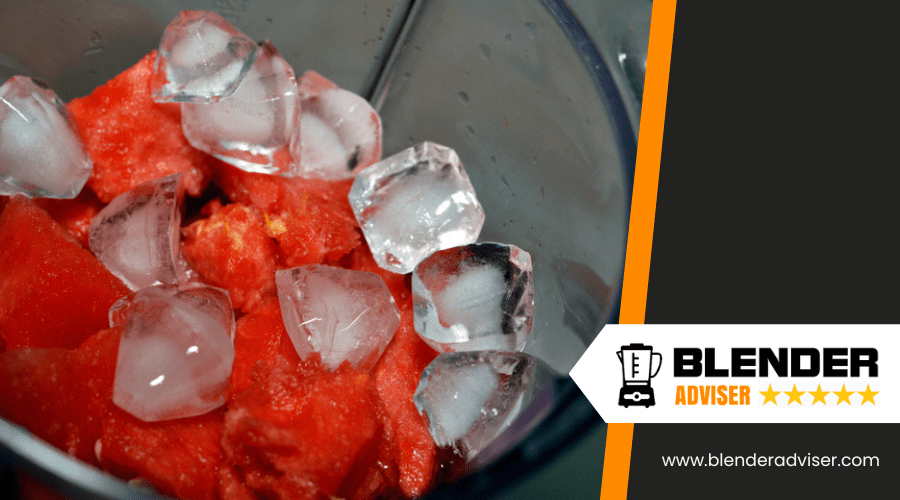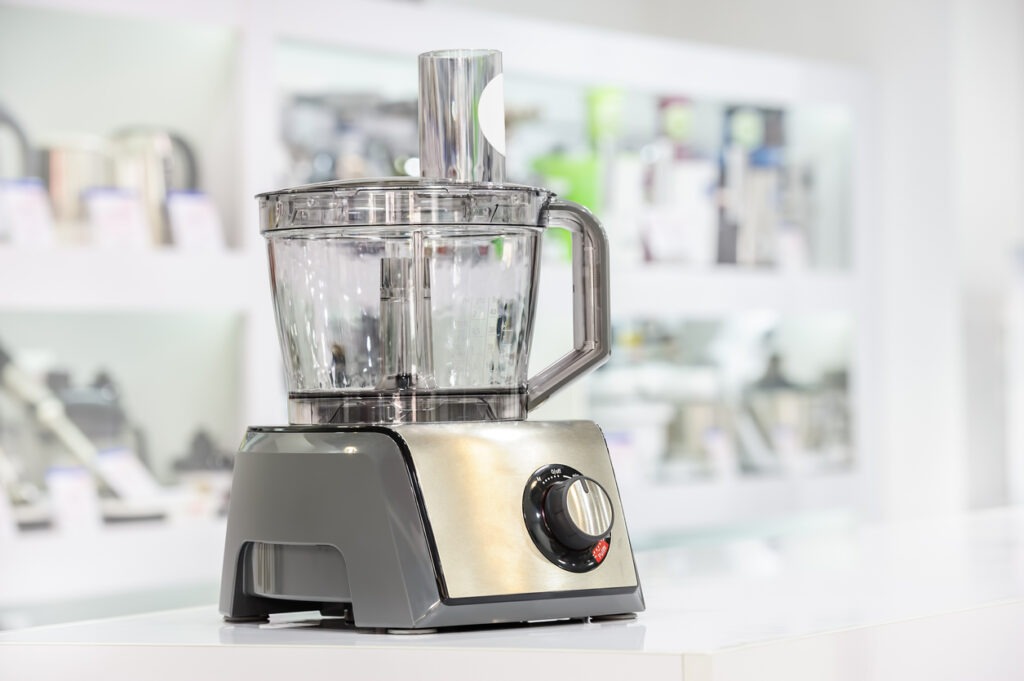When faced with the task of making a smoothie, you might wonder if your food processor can handle blending ice, a common step in many recipes. While it’s true that some models can crush ice effectively using a pulsing technique, it’s crucial to understand the limitations and precautions.
This knowledge will not only protect your appliance but also ensure you achieve the consistency you desire. So, before you decide to throw in those ice cubes, consider what’s at stake for your food processor’s blades and motor. Let’s explore the factors that determine whether your kitchen workhorse can truly take on the challenge of ice.
Understanding Food Processors
Have you ever wondered how a food processor manages to chop, slice, and puree your food with such efficiency? It’s all thanks to the clever design and powerful motor that drives the blades, which are the heart of any food processor. These appliances are kitchen workhorses, designed to tackle a variety of tasks quickly and efficiently. With different types of blades, each suited for specific tasks, you can effortlessly chop vegetables, shred cheese, or even cut dough.
The versatility doesn’t end there. Food processors can also crush, making them quite handy when you need to break down harder ingredients. However, when it comes to crushing ice, it’s a bit of a different ball game. While your processor is up to the task, employing pulsing techniques is crucial to achieving the desired consistency without overburdening the machine. It’s also important to set realistic expectations about your processor’s ice-crushing capacity, especially when comparing it to dedicated ice crushers.
In essence, understanding your food processor’s capabilities and limitations is key to harnessing its full potential. Whether you’re prepping a feast or making a smoothie, knowing how to leverage those blades can make all the difference in your culinary creations.
The Challenge of Ice
You might encounter limitations when blending ice in a food processor, particularly regarding the quantity and the blade’s durability. It’s essential to consider whether your food processor’s blade is suitable for ice crushing, as not all are built to withstand the challenge. Understanding these factors can help you achieve the best results without damaging your appliance.
Ice Blending Limitations
Despite their versatility, food processors face significant challenges when it comes to crushing ice efficiently. While you can use them for this task, they’re not specifically designed for it. This means you need to proceed with caution to avoid damaging their blades or motor.
Pulsing is your best bet when using a food processor to crush ice, as it minimizes potential damage and strain on the machine. However, don’t expect the same consistency you’d get from a dedicated ice crusher. Also, it’s wise to limit ice crushing to small quantities.
Overloading your food processor with ice can quickly lead to wear and tear that shortens its lifespan, leaving you with a less effective kitchen tool.
Suitable Blade Types
To tackle the challenge of blending ice effectively, it’s crucial to opt for food processors equipped with specialized crush ice blades. These blades are specifically designed to handle the task, capable of breaking down ice into small, consistent pieces.
When you’re looking for a food processor to crush ice, selecting one with the right blade type ensures you get efficient and effective results. Remember, crush ice blades are unique and not suited for processing other types of foods due to their design.
Selecting the Right Processor
When choosing a food processor for blending ice, it’s essential to consider models with crush ice blades and powerful motors. These features ensure that the processor can handle the tough texture of ice cubes without wearing down or breaking. A food processor designed to crush ice will typically have specially designed blades that are robust enough to break down ice into the desired consistency, whether you’re aiming for finely crushed ice for smoothies or slightly larger pieces for cocktails.
Additionally, the motor’s power is a critical factor. A powerful motor ensures that the food processor can operate at a high speed, delivering the force needed to crush ice effectively. You’ll find that models with weaker motors might struggle with ice cubes, leading to inconsistent results or even damaging the appliance.
It’s also worth looking for a food processor with a pulse function. This feature gives you better control over the blending process, allowing you to achieve the perfect texture without over-processing the ice. Plus, opting for a processor with a large feed tube can make your life easier, as you can add ice cubes directly for blending without the need to pre-crush or break them down.
Lastly, choosing a versatile food processor that excels in various tasks, including ice blending, ensures you’re investing in a multi-functional kitchen tool. This versatility means you can enjoy a wide range of culinary creations, from smoothies to frozen desserts, with just one appliance.
Preparation Techniques
Before using your food processor to crush ice, it’s crucial to employ the right preparation techniques to ensure optimal results and prevent damage to the appliance. Understanding how to properly use your food processor to crush ice can make a big difference in the quality of your icy creations and the lifespan of your machine. Here’s how you can get ready:
- Start with smaller ice cubes or chunks: Large pieces can be harder on your processor. Smaller pieces are easier to break down and can help you achieve a more even consistency.
- Use the pulsing technique: Pulsing allows you to control the size of the ice pieces better. Quick pulses will give you small pieces, while longer pulses are good for larger chunks.
- Avoid overloading: Don’t fill the bowl to the brim with ice. Processing in batches ensures better results and protects the motor.
- Be mindful of liquids: If you’re crushing ice with some liquid, avoid turning it into a completely pulverized mixture unless that’s your goal. Keeping an eye on the texture will help you stop at the right moment.
Blade Types and Ice
Understanding the different blade types in your food processor is crucial for efficiently crushing ice. Your food processor isn’t just an alternative to an ice maker; it’s a tool that, when used correctly, can rival the consistency and quality of ice you’d expect from a dedicated machine. The key lies in the blades. Food processors come equipped with specialized blades designed specifically for crushing ice. These aren’t your average blades; they’re crafted to handle the tough, solid nature of ice without damaging the processor.
Some models include crush ice blades, making them perfect for your ice-crushing needs. Remember, not all food processors have this capability, so you’ll want to ensure yours is up to the task. Besides the right type of blade, a powerful motor and a large feed tube play significant roles in crushing ice effectively. They work together to handle larger pieces of ice and produce a consistent texture.
Additionally, mastering the pulsing technique can help you achieve the desired consistency of crushed ice. Quick, short pulses allow you to control the texture, ensuring you don’t end up with a slushy mess unless that’s what you’re aiming for. This technique is essential in making your food processor work for you as an effective ice maker.
Step-by-Step Guide
Now, you’ll learn how to master ice crushing with your food processor. We’ll cover the best techniques, identify which food processors are up to the task, and highlight essential safety precautions to keep in mind.
Ice Crushing Techniques
To crush ice effectively in a food processor, start by using a pulsing technique to achieve the desired consistency. This method ensures you get the exact size of ice pieces you’re aiming for, whether it’s finely crushed ice for slushies or coarser pieces for cocktails. When you don’t have a pulse button, quick on/off cycles will do the trick. It’s crucial to process ice in limited quantities to avoid overwhelming your machine and to prevent turning your ingredients into a liquid mess.
- Pre-chill your ingredients: Keeping your ingredients cold ensures better texture.
- Use the pulse feature: Adjust pulsing duration for different ice sizes.
- Avoid overfilling: Process ice in batches for consistency.
- Consider a bag and rolling pin: For pre-crushing, making it easier for your food processor.
Suitable Food Processors
When choosing a food processor for crushing ice, models like the Cuisinart DLC-10S Pro Classic 7-Cup are equipped to handle the task with care. These processors often boast stainless steel blades robust enough to tackle small amounts of ice without compromising the machine’s integrity.
It’s essential to use the pulsing technique for achieving your desired ice consistency while avoiding the complete pulverization of any liquid ingredients mixed in. Remember, food processors may not yield the same results as dedicated ice crushers, so it’s crucial to set realistic expectations regarding their ice crushing capacity.
This approach ensures you get the most out of your food processor without pushing it beyond its limits or risking damage.
Safety Precautions
Having explored the suitable food processors for crushing ice, it’s crucial you understand the safety precautions to prevent damage to your appliance and ensure your safety. While food processors can tackle the task with caution, here are key steps to follow:
- Use the pulsing technique to crush ice, applying quick on/off cycles if there’s no pulse option.
- Avoid completely pulverizing liquid ingredients with the ice to prevent appliance overload.
- Consider alternative methods like a Lewis Bag and Rolling Pin for a safer, appliance-friendly option.
- Always ensure the lid is securely fastened to prevent any ice shards from escaping during the process.
Adhering to these precautions not only safeguards your food processor but also ensures a smoother and safer ice-crushing experience.
Safety Considerations
Before attempting to crush ice in your food processor, it’s crucial to consider several safety measures to prevent damage to the appliance. First off, remember that not all food processors are built to handle the rigors of ice crushing. You’ll want to ensure yours is up to the task to avoid any potential damage, especially to the blades.
When you do proceed, always crush ice in small batches. This approach minimizes strain on the food processor’s motor and prevents the blades from becoming damaged due to excessive force. Using the pulse function during this process can also help by giving the motor brief breaks, reducing the risk of overheating.
Moreover, adding a small amount of liquid to the ice can significantly ease the crushing process. This little trick works by lubricating the ice, allowing the blades to cut through more smoothly and efficiently. Nevertheless, it’s essential to monitor the ice’s consistency closely while processing. Keeping an eye on it ensures you don’t overdo it and end up straining or even breaking your food processor.
Pros and Cons
While food processors can indeed crush ice, weighing the advantages and disadvantages of this method is essential for optimal use. Your food processor isn’t just for slicing veggies or mixing dough; it can also tackle ice with the right approach and caution. However, understanding both sides of the coin will help you make the most of this capability without risking damage to your appliance or compromising the texture of your icy creations.
Pros and cons of using a food processor to crush ice:
- Versatility: Your food processor can handle various types of food and tasks, including making crushed ice for refreshing iced tea or cocktails. This multi-use capability means you don’t need a separate appliance just for ice.
- Customization: By pulsing, you control the ice’s size, creating either finely crushed pieces or slightly larger chunks for different purposes.
- Convenience: There’s no need to buy a separate ice crusher if your processor comes with a crush ice blade, making it a convenient, all-in-one kitchen tool.
- Inconsistency: While handy, food processors may not provide the uniformity in ice texture that dedicated ice crushers do, which could affect the quality of your iced tea or other icy beverages.
Alternative Ice Crushing Methods
If you don’t have a food processor or prefer not to use it for ice, several effective alternative methods can help you crush ice for your drinks and recipes. One common technique involves placing ice cubes in a resealable plastic bag and gently pounding them with a rolling pin. This method isn’t only simple but also allows you to control the size of the crushed ice.
Alternatively, you could use a kitchen mallet or a large wooden spoon to crush the ice directly in a bowl. These tools are especially handy when you need a quick solution without setting up any equipment.
For those who often need crushed ice in larger quantities, investing in a Lewis bag might be worth considering. This canvas bag is designed to absorb excess water, leaving you with drier, more consistent crushed ice.
A more specialized approach involves using a cocktail shaker and muddler. This method is particularly useful for preparing beverages, as it lets you crush ice directly in the shaker, ensuring your drinks are chilled to perfection. Plus, it adds a bit of flair to your cocktail preparation routine.
Maintenance After Ice
After exploring alternative methods for crushing ice, it’s crucial to focus on how to properly maintain your food processor once you’ve used it for this purpose. Taking good care of your appliance ensures it remains in top condition for all your culinary needs. Here’s what you should do:
- Clean the food processor thoroughly after crushing ice to remove any ice particles and prevent damage. This step is vital to avoid any lingering moisture which can harm the appliance over time.
- Dry all components completely to prevent rust or corrosion from residual moisture. Ensuring everything is dry thoroughly helps maintain the integrity of your food processor’s parts.
- Check the blade and bowl for any signs of wear or damage caused by processing ice. The blades are particularly susceptible to dulling or damage, so inspect them carefully.
- Store the food processor in a dry and cool place to maintain its functionality and longevity. This simple practice can significantly extend the life of your appliance.
Conclusion
In summary, you can crush ice with a food processor, but proceed with caution. Ensure you’re using the right processor, and adopt a pulsing technique for the best results. Remember, the type of blade matters, and always prioritize safety.
While food processors offer a versatile option, they may not match the efficiency of dedicated ice crushers. Consider alternative methods if you’re not satisfied, and don’t forget about maintenance to keep your processor in top shape.





